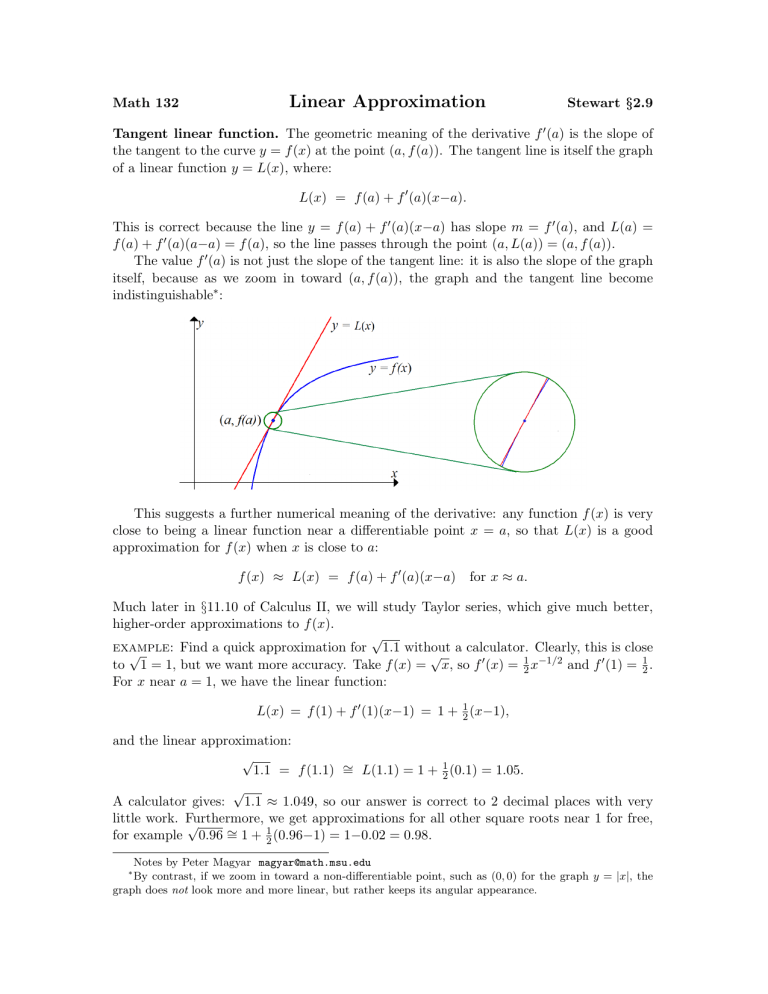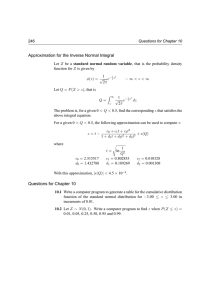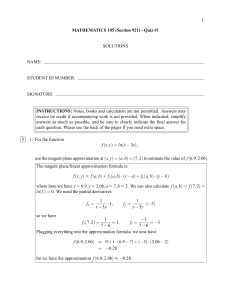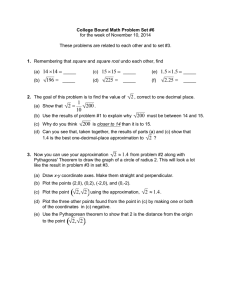
Math 132 Linear Approximation Stewart §2.9 Tangent linear function. The geometric meaning of the derivative f 0 (a) is the slope of the tangent to the curve y = f (x) at the point (a, f (a)). The tangent line is itself the graph of a linear function y = L(x), where: L(x) = f (a) + f 0 (a)(x−a). This is correct because the line y = f (a) + f 0 (a)(x−a) has slope m = f 0 (a), and L(a) = f (a) + f 0 (a)(a−a) = f (a), so the line passes through the point (a, L(a)) = (a, f (a)). The value f 0 (a) is not just the slope of the tangent line: it is also the slope of the graph itself, because as we zoom in toward (a, f (a)), the graph and the tangent line become indistinguishable∗ : This suggests a further numerical meaning of the derivative: any function f (x) is very close to being a linear function near a differentiable point x = a, so that L(x) is a good approximation for f (x) when x is close to a: f (x) ≈ L(x) = f (a) + f 0 (a)(x−a) for x ≈ a. Much later in §11.10 of Calculus II, we will study Taylor series, which give much better, higher-order approximations to f (x). √ example: Find a quick approximation for 1.1 without a calculator. Clearly, this is close √ √ to 1 = 1, but we want more accuracy. Take f (x) = x, so f 0 (x) = 12 x−1/2 and f 0 (1) = 12 . For x near a = 1, we have the linear function: L(x) = f (1) + f 0 (1)(x−1) = 1 + 12 (x−1), and the linear approximation: √ 1.1 = f (1.1) ∼ = L(1.1) = 1 + 12 (0.1) = 1.05. √ A calculator gives: 1.1 ≈ 1.049, so our answer is correct to 2 decimal places with very little work. Furthermore, we get approximations for all other square roots near 1 for free, √ 1 ∼ for example 0.96 = 1 + 2 (0.96−1) = 1−0.02 = 0.98. Notes by Peter Magyar magyar@math.msu.edu By contrast, if we zoom in toward a non-differentiable point, such as (0, 0) for the graph y = |x|, the graph does not look more and more linear, but rather keeps its angular appearance. ∗ example: √Approximate sin(42◦ ) without a scientific calculator. This is clearly close to sin(45◦ ) = 22 ≈ 0.71, so let us take a = 45◦ . Now, to use calculus with trig functions, we √ 2 2 L(x) = The linear approximation is: 2π sin(42◦ ) = sin 42( 360 ) ≈ L(x) = √ 2 2 , √ 2 π 2 (x− 4 ). + √ 2 2 rad. Thus f 0 (a) = sin0 ( π4 ) = cos( π4 ) = π 4 2π )= must always convert to radians: a = 45( 360 and we have the linear function: √ 2 2 + 2π 42( 360 )− π4 √ = 2 2 √ − 2 2 π 60 ≈ 0.67. A scientific calculator gives sin(42◦ ) ≈ 0.669, so again the linear approximation is accurate to two decimal places. Error sensitivity. We can rewrite the linear approximation f (x) ≈ f (a) + f 0 (a)(x−a) as: ∆f = f (x)−f (a) ≈ f 0 (a)(x−a) = f 0 (a) ∆x. That is, we can approximate the change in f (x) away from f (a), in proportion to the change in x away from a. In Leibnitz notation, with y = f (x), we write this as: ∆y ≈ dy dx ∆x. dy dy = dx |x=a = f 0 (a). If we think of ∆x as an error from an intended input Here we mean dx value x = a, then ∆f ≈ f 0 (a) ∆x approximates the error from the intended output f (a). example: A disk of radius r = 5 cm is to be cut from a metal sheet weighing 3 g/cm2 . If the radius is measured to within an error of ∆r = ±0.2 cm, what is the approximate range of error in the weight? This is the kind of error-control problem from our limit analyses in Notes §1.7, only now we have the powerful tools of calculus to give a simple answer. The weight is the density 3 times the area πr2 , given by the function: W = W (r) = 3πr2 with W (5) = 75π ≈ 235.6, and we aim to find the error ∆W away from this intended value. Since: dW dr = 3π(2r) = 6πr and dW dr |r=5 = 30π, we have the approximate error: ∆W ≈ dW dr ∆r = 30π ∆r. Thus, for ∆r = ±0.2, we have ∆W ≈ 30π(0.2) ≈ 18.8. That is: r = 5 ± 0.2 cm =⇒ W ≈ 235.6 ± 18.8 g . The point here is not just the specific error estimate, but the formula which gives, for any small input error ∆r, the resulting output error ∆W ≈ 30π ∆r ≈ 94 ∆r. The coefficient 30π measures the sensitivity of the output W to an error in the input r. Differential notation. For y = f (x), we rewrite a small ∆x as dx, and we define: dy = dy dx dx and df = f 0 (x) dx. The dependent quantity dy is called a differential: we can think of it as the linear approximation to ∆y, as pictured below: example: We can rewrite the approximation in the previous example as: ∆W ≈ dW = dW dr dr = 2 d dr (3πr ) dr = 6πr dr. Here dr is just another notation for ∆r, and the approximation ∆W ≈ 6πr ∆r is valid near any particular value of r, such as r = 5 in the example. Linear Approximation Theorem. How close is the approximation ∆y ≈ dy, or equivalently f (x) ≈ L(x) = f (a) + f 0 (a)(x−a)? In fact, the difference between f (x) and L(x) is not only small compared to ∆x = x−a, but usually proportional to (∆x)2 = (x−a)2 , which becomes tiny as ∆x → 0. (E.g. if ∆x = 0.01, then (∆x)2 = 0.0001.) Also, the slower the derivative f 0 (x) changes near x = a, the closer y = f (x) is to its linear approximation, and this is measured by the rate of change of f 0 (x), namely the second derivative f 00 (x). The following theorem gives an upper bound on the error in the linear approximation, ε(x) = f (x) − L(x). Theorem: Suppose f (x) is a function such that |f 00 (x)| < B on the interval x ∈ [a−δ, a+δ]. Then, for all x ∈ [a−δ, a+δ], we have: f (x) = f (a) + f 0 (a)(x−a) + ε(x), where |ε(x)| < B|x−a|2 . We give the proof, based on the Mean Value Theorem, later in §3.2. √ example: For f (x) = x near x = 1, we have f 0 (x) = 12 x−1/2 and f 0 (1) = f 00 (x) = − 14 x−3/2 , and on the interval x ∈ [0.9, 1.1], we have: |f 00 (x)| ≤ |f 00 (0.9)| = 14 (0.9)−3/2 ≈ 0.29 < 13 . Thus we may take B = 13 , and find that: √ √ x = 1 + 31 (x−1) + ε(x), where |ε(x)| < 31 |x−1|2 . For example, the error at x = 1.1 is |ε(1.1)| < 13 (0.1)2 < 0.004, so: √ 1.1 = 1 + 21 (0.1) ± 0.004 = 1.05 ± 0.004 . 1 2. Also




